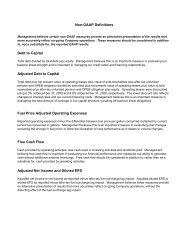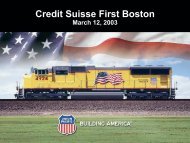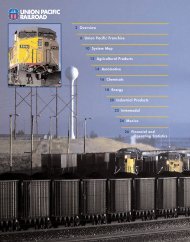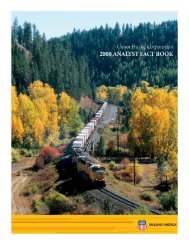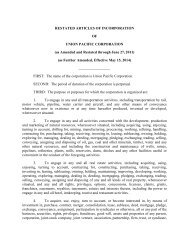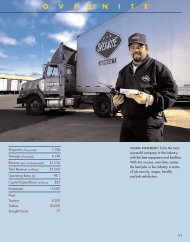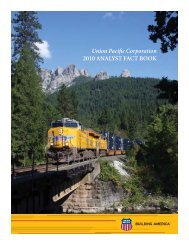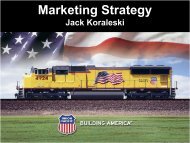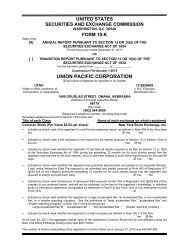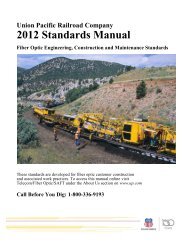Operations - Union Pacific
Operations - Union Pacific
Operations - Union Pacific
Create successful ePaper yourself
Turn your PDF publications into a flip-book with our unique Google optimized e-Paper software.
S a f e t y a n d t h e E n v i ro n m e n t<br />
Safety<br />
Environment<br />
Safety is a core value at <strong>Union</strong> <strong>Pacific</strong>. All employees are<br />
responsible for maintaining safe working conditions and<br />
preventing personal injuries and accidents. UP’s commitment<br />
to safety extends beyond its own employees and includes both<br />
customers and the communities in which UP operates. In<br />
2006, the safety of our employees improved as the number of<br />
incidents was reduced 13 percent. Rail equipment incidents<br />
decreased 17 percent and the associated costs fell 13 percent.<br />
SAFETY INCIDENTS AND REPORTABLES<br />
3.19 3.16<br />
2.68<br />
1.86<br />
Incidents<br />
Reportables<br />
1.75<br />
1.69<br />
2004 2005 2006<br />
Crossing accidents have increased nationwide in recent years<br />
with the growth in rail and highway traffic. <strong>Union</strong> <strong>Pacific</strong> is<br />
working to reverse that trend through improved crossings,<br />
technology and education. In 2006, UP closed 409 crossings<br />
to reduce exposure to possible grade crossing accidents.<br />
Technology such as locomotive simulators and track image<br />
recorders (TIRs) are being utilized to improve crossing safety.<br />
Simulators help teach and reinforce safe operating practices for<br />
employees and TIRs assist in the analysis of crossing accidents.<br />
At year end 2006, <strong>Union</strong> <strong>Pacific</strong> had TIRs in roughly 30 percent<br />
of its road locomotive fleet. In addition, driver behavior is<br />
addressed through public education classes and initiatives with<br />
local police agencies to promote greater crossing safety.<br />
<strong>Union</strong> <strong>Pacific</strong> is partnering with Dow Chemical, <strong>Union</strong> Tank<br />
Car and the Federal Railroad Administration on the “Next<br />
Generation Tank Car Project” to further improve the safety of<br />
chemical transportation through better tank car design. The<br />
Company is also testing Communications-Based Train Control,<br />
a technology that enhances train safety through the use of<br />
global positioning satellites and onboard computer technology.<br />
In 2007, UP will continue its multifaceted approach to safety<br />
through employee education and training, public awareness<br />
and derailment prevention.<br />
<strong>Union</strong> <strong>Pacific</strong> is committed to protecting the nation’s<br />
environment. As one of America’s largest transportation<br />
companies, UP’s role is critical to the U.S. economy. It is also<br />
critical that this service is provided in a manner that protects<br />
the country’s natural resources.<br />
One area where railroads offer a significant advantage over<br />
other forms of freight transportation is fuel efficiency. For<br />
example, railroads are generally three times more fuel efficient<br />
than trucks. <strong>Union</strong> <strong>Pacific</strong> is continually improving its fuel<br />
efficiency through better locomotive technology, engineer<br />
training and employee involvement. One of the most<br />
successful initiatives has been the innovative Fuel Masters<br />
program, which rewards locomotive engineers for efficiently<br />
operating trains. Increased asset utilization and network<br />
efficiency also has enabled the Company to improve its fuel<br />
consumption. For example, improved efficiency versus 2005<br />
allowed UP to save more than 50 million gallons of diesel fuel<br />
in 2006. Since 1995, the Company has achieved a more than 12<br />
percent improvement in fuel efficiency.<br />
<strong>Union</strong> <strong>Pacific</strong> is aggressively working to become even “cleaner<br />
and greener” through the reduction of locomotive emissions.<br />
There are three sets, or tiers, of emission standards provided<br />
by the U.S. Environmental Protection Agency (EPA), which<br />
are progressively more stringent. Over time, these standards<br />
require continuing reductions in locomotive exhaust<br />
emissions of nitrogen oxides and particulate matter. With<br />
approximately 50 percent of its nearly 8,500 locomotives<br />
certified under the applicable EPA tier standards, UP owns<br />
the most environmentally friendly fleet in the nation. Further<br />
improvements are on the horizon as the Company works with<br />
manufacturers to field-test new, high-horsepower locomotives<br />
that surpass the EPA’s most stringent standards and older<br />
locomotives are retrofitted with new emission-reduction<br />
equipment.<br />
6
To help reduce emissions in train yards, UP tested the world’s<br />
first “Green Goat” hybrid switching locomotives. These<br />
locomotives combine diesel engines with battery-powered<br />
electric motors, and are estimated to reduce emissions 80<br />
percent and improve fuel consumption 16 percent versus<br />
conventional switching locomotives. The Company has more<br />
than 20 of these units in service today, in major urban areas<br />
such as Houston and Los Angeles. Along with the “Green<br />
Goat” hybrids, UP is also pioneering another low emissions<br />
switch locomotive, the “Genset Switcher”. These units utilize<br />
“off-road” truck-style diesel engines that are expected to reduce<br />
emissions and fuel consumption at similar levels to the “Green<br />
Goat” units. Both of these new switching locomotives are<br />
significantly “cleaner and greener” than required by current<br />
EPA requirements. The California Air Resources Board has<br />
designated both types as “ultra-low-emitting locomotives.”<br />
<strong>Union</strong> <strong>Pacific</strong> has a comprehensive waste reduction and<br />
recycling program that touches nearly every part of the<br />
company. Concerted efforts are made to address high-volume<br />
items such as wooden track ties and used oil. When possible,<br />
wooden track ties are refurbished for use elsewhere on the<br />
UP system or sold to landscaping or recycling companies.<br />
The Company is installing more-durable concrete ties, which<br />
require lower maintenance and generate less waste than<br />
wooden ties.<br />
UP’s standard operating equipment for fueling and locomotive<br />
maintenance activities is designed to prevent overflows and<br />
spills. On-board retention tanks capture residual oil from<br />
locomotives for proper disposal. Recycling used oil is a high<br />
priority at <strong>Union</strong> <strong>Pacific</strong>, and 100 percent of oil captured is<br />
recycled.<br />
UP is also actively working to recycle one of the fastest growing<br />
sources of waste, “e-waste”. This is generally characterized<br />
as old, out-dated computers and other electronic devices.<br />
UP evaluates any electronic equipment no longer needed to<br />
determine if it can be recycled, reused or rebuilt. Since 2003,<br />
the Company has recycled more than 293,000 pounds of<br />
electronic equipment and nearly 6 million pounds of batteries.<br />
“Green Goat” hybrid yard locomotive<br />
Did you know...<br />
• In 2006, on average, <strong>Union</strong> <strong>Pacific</strong> hauled one ton of<br />
freight over 780 miles on a single gallon of diesel fuel<br />
• One double stack intermodal train equals up to 280 trucks<br />
traveling on the highway<br />
• In terms of noxious emissions, trains are 3 times cleaner<br />
than trucks on a per ton-mile basis<br />
• If 25 percent of truck freight was diverted to rail<br />
transportation, nearly 800,000 fewer tons of air pollution<br />
would be created by 2025.<br />
7
Network Management<br />
Operating strategies aimed at network simplification,<br />
technology, and capital investments resulted in better<br />
service reliability and efficiency throughout 2006. Ongoing<br />
Unified Plan initiatives reduced the overall workload on the<br />
network and improved transportation planning. Continuous<br />
improvement initiatives simplified terminal operations,<br />
increased throughput and reduced traffic bottlenecks at key<br />
locations throughout the network. The Customer Inventory<br />
Management System (CIMS) rollout accelerated across the<br />
system in 2006. This technology solution proactively manages<br />
terminal inventories, matching rail and customer capacity by<br />
monitoring customer inventory and storage capabilities along<br />
with freight cars enroute and freight cars awaiting delivery.<br />
System implementation should be complete in 2007.<br />
The Company’s Network Planning function utilizes the<br />
business planning process to strengthen the vital link<br />
between the Market and Sales and Operating departments.<br />
Marketing and Sales provides detailed shipment forecasts<br />
to Network Planning personnel who model the forecast<br />
against network capacity. Where constraints are identified,<br />
Operating management works with Marketing and Sales to<br />
prioritize new business opportunities by profitability, evaluate<br />
process improvement initiatives (to increase capacity) and<br />
review alternative transportation routes. In an environment<br />
of growing rail demand and limited capacity, this increased<br />
organizational linkage is crucial to optimize network<br />
coordination and efficiency.<br />
Unified Plan<br />
The Unified Plan effort takes a “clean sheet” approach to <strong>Union</strong><br />
<strong>Pacific</strong>’s transportation plan, simplifying network complexity<br />
while increasing system velocity and asset utilization. Key plan<br />
elements include the elimination of mainline work events and<br />
the reduction of intermediate switching events. In 2006, the<br />
Company’s work event rate improved 11 percent versus 2005,<br />
and the switch rate fell by nearly 5 percent. UP purchased<br />
network modeling software to improve the planning process<br />
by forecasting network impacts of various traffic scenarios.<br />
This increased forecasting capability, combined with greater<br />
“network” awareness at the local operating manager level, is<br />
driving better operational efficiency and balance.<br />
UNIFIED PLAN BUSINESS PROCESS<br />
Leadership<br />
& Culture<br />
Organization<br />
Design &<br />
Competency<br />
Unified Plan<br />
Business<br />
Process<br />
Measurement &<br />
Accountability<br />
Unified Plan initiatives will continue to be implemented in<br />
2007 and beyond. The process is considered “evergreen”, as the<br />
growing demand for rail service offers new challenges from<br />
those faced at plan inception. Our on-going focus will be<br />
better planning tools, balanced traffic flows, further work and<br />
switch event reductions and overall system congestion relief.<br />
Continuous Improvement Efforts<br />
Information<br />
Systems & Data<br />
Integrity<br />
<strong>Union</strong> <strong>Pacific</strong> uses a variety of management processes<br />
to further enhance network productivity and efficiency,<br />
particularly at the terminal level. The Company has a core<br />
team of personnel who combine industrial engineering<br />
training and familiarity with railroad knowledge and<br />
experience. This group applies techniques like Lean<br />
management to improve operations at key points throughout<br />
the network. The Lean concept focuses on opportunities to<br />
improve efficiency by reducing movements, inventories, defects<br />
and rework. The goal of these projects is to increase capacity<br />
without capital investment, by streamlining operational<br />
processes and reducing complexity.<br />
Improved flow processing in our locomotive repair facilities<br />
resulted in reduced cycle times, freeing additional locomotives<br />
to serve customers and haul freight. Terminal operations,<br />
which have been a primary focus in the past year, are also more<br />
efficient. Congestion related delays have been reduced by up to<br />
90 percent following implementation at key system areas such<br />
as Roseville and Chicago. The team’s work is now expanding<br />
to other critical service units and routes that have maximum<br />
leverage on the network.<br />
8
P roj e c t H o u s t o n<br />
The Houston service unit is a key part of the <strong>Union</strong> <strong>Pacific</strong><br />
network. Large volumes of diverse traffic originate and pass<br />
through this area every day, both for shipment to other points<br />
on the system and for interchange with rail carriers in the East.<br />
The Houston metropolitan area is operationally complex, as<br />
a series of railroad terminal locations are separated by the<br />
business and housing developments that make up this large<br />
population center. Traffic is often required to be interchanged<br />
between the various area facilities, depending on destination<br />
and capacity limitations of the individual locations. Early in<br />
2006, a multi-faceted effort began to improve train flow and<br />
velocity in and around Houston.<br />
FREIGHT CAR TERMINAL DWELL HOURS<br />
Houston Service Unit<br />
30.6<br />
29.3<br />
27.2<br />
2004 2005 2006<br />
A cross-functional team, composed of personnel from<br />
continuous improvement, network planning, local operating<br />
managers, and the mechanical department, all took part in<br />
the project. Unified Plan changes reduced car inventories and<br />
internal workload, trimming work events and more effectively<br />
flowing traffic. For example, Settegast and Englewood, the<br />
two largest classification facilities in the Houston complex<br />
previously handled traffic moving in all directions out of<br />
Houston. Project Houston changed the transportation plan<br />
to have each facility handle traffic based on their geographic<br />
location. Settegast, which is located in northeast Houston, now<br />
handles traffic destined for the North and East. Englewood,<br />
located in southwest Houston, handles traffic to the South and<br />
West. This flow process eliminated interchanges between the<br />
two yards, removing congestion and switch events.<br />
UNIFIED PLAN CHANGES - HOUSTON<br />
Additional efforts involving corridor management teams<br />
focused on leveraging the existing asset base to improve<br />
velocity and traffic flow in the key corridors into and out of<br />
Houston. The locomotive group revised the servicing network<br />
for the 250 yard and local locomotives to reduce servicing<br />
time and improve availability. The local terminal operations<br />
personnel took responsibility for daily execution of the<br />
transportation plan and service reliability.<br />
Houston-area operations have clearly improved. Service unit<br />
velocity increased nearly 10 percent from 2005, indicating<br />
better fluidity and throughput. Industry spot/pull percentage,<br />
which measures the first and last customer interface, also<br />
increased nearly 10 points to 86 percent overall for the service<br />
unit. On time train departures improved 19 percent. The<br />
initiatives put in place will remain “evergreen”, evolving as<br />
Houston’s business mix grows and changes in the years to<br />
come.<br />
North<br />
East<br />
Settegast<br />
West<br />
Locals<br />
South<br />
Englewood<br />
Locals<br />
Traffic Destined North and East<br />
Traffic Destined South and West<br />
Existing Rail line<br />
9
I n v e s t i n g i n O u r F u t u re<br />
<strong>Union</strong> <strong>Pacific</strong>’s 32,000 plus mile network requires a large<br />
capital commitment each and every year in order to maintain<br />
safe operations, support the transportation needs of our<br />
current and future customers and improve operational<br />
efficiency. The Company expects to make capital investments<br />
totaling $3.2 billion in 2007. Annual track maintenance across<br />
the Railroad’s system will make up nearly half, at approximately<br />
$1.5 billion. The Company plans to replace 4.3 million ties,<br />
spread 6.6 million tons of rock ballast, replace 870 miles of<br />
rail and surface 8,200 miles. UP also plans to acquire 300 new<br />
high-horsepower long-haul locomotives and 800 freight cars.<br />
New freight cars and environmentally-friendly locomotives<br />
are added to our fleet annually to replace older, less efficient<br />
equipment and support growth.<br />
Sunset Corridor Expansion<br />
One of <strong>Union</strong> <strong>Pacific</strong>’s key routes is the Sunset Corridor, which<br />
runs between Los Angeles and El Paso. This heavily traveled<br />
corridor carries about 20 percent of all traffic operated by the<br />
Railroad. UP added 56 miles of double track to the 760 mile<br />
route in 2006, making it approximately 50 percent double<br />
tracked.<br />
Current Sunset Corridor capacity is roughly 50 to 52 trains<br />
per day. UP’s freight demand in that corridor exceeds capacity<br />
today and future growth expectations will further increase<br />
demand. In particular, international intermodal shipments<br />
are expected to annually grow at least 6 percent over the<br />
next several years. Although the Company was on a pace to<br />
completely double track the route in the next seven or eight<br />
years, strong demand has led to the Company’s decision to<br />
accelerate the project. UP now plans to complete the double<br />
track over the next 4 years.<br />
Terminals along the Sunset Corridor are also being expanded<br />
and upgraded to support the rising traffic levels anticipated<br />
with the route expansion. Construction of a new intermodal<br />
facility in San Antonio, TX will begin during 2007 to<br />
accommodate the projected traffic growth flowing from the<br />
corridor in addition to providing operational flexibility for<br />
the Company upon completion in 2008. Additional track<br />
construction and facility upgrades are planned at terminals in<br />
Los Angeles, Yuma, Tucson, and El Paso over the course of the<br />
project.<br />
Once completed, capacity on the Sunset Corridor will nearly<br />
double to 90 plus trains per day. The added capacity also<br />
helps network efficiency, providing an alternate route during<br />
maintenance on other system areas, and improving system<br />
service recoverability.<br />
SUNSET CORRIDOR<br />
LA Basin<br />
West Colton*<br />
Phoenix<br />
Second Main Track Completed<br />
Second Main Track to be Completed in 2007<br />
2007 Terminal Improvements<br />
*<br />
Calexico<br />
Yuma*<br />
Picacho<br />
Tucson*<br />
Lordsburg<br />
El Paso<br />
Nogales<br />
10
Joint Line Expansion<br />
A key strength of <strong>Union</strong> <strong>Pacific</strong> is its access to the Southern<br />
Powder River Basin (SPRB) coal fields of northeastern<br />
Wyoming. Coal currently powers approximately 50 percent<br />
of U.S. electrical generation, and with the electricity needs<br />
of the country continuing to build, strong demand growth is<br />
expected to continue. SPRB coal is particularly attractive due<br />
to its relatively low cost and reduced sulfur content. Capacity<br />
expansion is underway on the UP/BNSF Joint Line (the Joint<br />
Line) serving the SPRB. Approximately 25 miles of third main<br />
track and 31 miles of fourth main track will be added during<br />
the expansion. When these projects are complete in 2008, the<br />
Joint Line will be 100 percent triple mainline with quadruple<br />
mainline in key areas. This expansion should support expected<br />
SPRB coal growth as well as improve the ability to perform<br />
Joint Line maintenance while reducing train delay and<br />
congestion. Signal and capacity upgrades across Nebraska and<br />
Iowa are also planned, which will help train dispatching and<br />
the flow of coal traffic across the Midwest.<br />
SOUTHERN POWDER RIVER BASIN JOINT LINE<br />
Caballo Mine<br />
Belle Ayr Mine<br />
Cordero Rojo Complex<br />
Antelope Mine<br />
UP<br />
Bill<br />
Yard<br />
Coal Creek Mine<br />
Coal Creek Hill<br />
Jacobs Ranch<br />
Black Thunder<br />
South Black Thunder<br />
North Antelope<br />
Rochelle<br />
Logan Hill<br />
Whitetail Hill<br />
N<br />
Fourth Main Joint Line Track<br />
Third Main Joint Line Track<br />
BNSF Track<br />
11
Track and Terminal Density<br />
Lane density based on carloadings<br />
Line thickness depicts traffic density<br />
2006 Terminal Volumes<br />
Average Daily<br />
Major Classification Yards<br />
Volume/Cars<br />
North Platte 2,900<br />
Proviso (Chicago) 1,700<br />
North Little Rock 1,600<br />
Englewood (Houston) 1,400<br />
Roseville 1,400<br />
Livonia 1,400<br />
Pine Bluff 1,300<br />
West Colton 1,300<br />
Fort Worth 1,300<br />
Neff (Kansas City) 1,000<br />
Annual<br />
Major Intermodal Terminals<br />
Lifts<br />
ICTF (Los Angeles) 725,000<br />
Marion (Memphis) 406,000<br />
East Los Angeles 329,000<br />
Global I (Chicago) 321,000<br />
Global II (Chicago) 297,000<br />
Dallas 284,000<br />
Oakland 268,000<br />
Yard Center (Chicago) 248,000<br />
Seattle 238,000<br />
Englewood (Houston) 206,000<br />
12



